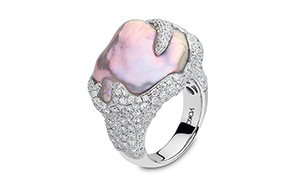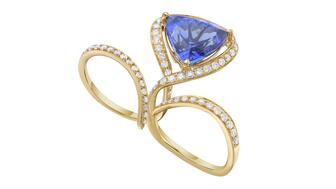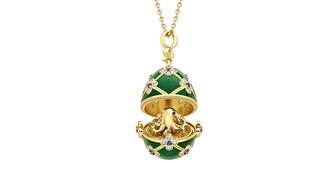Set in a Tiffany & Co. necklace, it sold for $4.2 million, the highest price and price per carat paid for a Paraíba tourmaline at auction.
Rocks On: Pearls, fit for a new generation
In the first installment of Rocks On, a new feature highlighting a different colored gemstone each month, National Jeweler examines the resurging popularity of pearl jewelry, showcasing 16 designs with a modern twist.
New York--These days, pearls are no longer just for your grandmother’s strand.

“The American market is really starting to wake up,” said Michael Hakimian, CEO of pearl jewelry brand Yoko London. “It’s rapidly becoming our best market.”
While a wide gap exists between the prices of natural and cultured pearls, both types are being snapped up at the high end of the market, cultured because of their prevalence and lower price point, and natural because of their rarity and uniqueness.
Bonhams, for one, has noted the prices paid for natural pearls at auction increasing over the past few years, with a few sales even setting records.
In April, a pair of natural pearl and diamond earrings sold for $493, 875, double their original estimate. That same month, a single 11.5 mm natural pearl mounted in a ring sold for $50,996, which was 10 times its highest estimate.
High-quality natural pearls are setting records at auction in part because of their rarity, as the supply in the market wanes. Good examples of natural pearls, based on their size, uniform shape, luster and blemish-free skin, aren’t appearing as often as they used to, Bonhams said.
The auction house also is attributing part of the recent boom to the celebrity factor, with actress Sarah Jessica Parker and The Duchess of Cambridge Kate Middleton, plus singer Katy Perry and actress Angelina Jolie, seen wearing pearls recently.
Middleton, who has a strong influence on the fashion world, especially is known for her ability to create classic and modern looks, giving consumers ideas on how to incorporate pearl jewelry into their outfits today.
“We’re seeing a huge revival in pearls from a whole range of women,” said Susan Abeles, director of U.S. jewelry at Bonhams in New York. “People are looking for ways to incorporate something elegant and classic into their wardrobe, so we do see it as a blossoming trend.”
She notes
“People these days are investing in fine art, which could be a piece of fine jewelry even, including at the high end of pearls.”
The battle of supply versus demand
As the recent recession went into full swing, many pearl suppliers pulled back, decreasing production to accommodate the changing economic tide. At the same time, demand was starting its rise.
“When the price of gold went up, people had to look at more reasonably priced things, and pearls fit right in,” said Russell Shor, senior industry analyst at the Gemological Institute of America.
Though prices for pearls have been relatively consistent over the past few years, they are slowly trending upward will continue to increase as demand picks up.
There also are fewer low-quality pearls on the market these days, Shor said, which adds to the health of the market.
Even as there are fewer low-quality goods entering the market, many note that there also is a smaller supply of higher-quality pearls due to those aforementioned smaller production numbers.
Mikimoto America COO Meyer Hoffman said they’re seeing a shortage in high-quality pearls when it comes to Akoya and South Sea varieties, as well as a greater limit to available sizes.
Since it takes a few years for production of pearls to pick back up and hit the market, squeezing the supply in the meantime, Hakimian told National Jeweler, “What’s important here is the long term. The vital part of this business is keeping relationships with your suppliers and satisfying demand from your customers.”
The traditional players of the pearling industry continue to supply the market, including China, Australia, Indonesia and Tahiti. But the GIA is also working with the Bahrain Ministry of Industry and Commerce and the Bahrain Economic Development Board to develop the country’s Gemstone and Pearl Testing Laboratory (GPTLB) into a leading research center for natural pearls.
The project aims to protect and expand Bahrain’s pearl industry, which once was one of the most important parts of the country’s economy but lost ground at the discovery of oil and the development of cultured pearls, by increasing capacity, research, expertise and technology at the GPTLB, as well as identifying further opportunities for growth.
Color, unique shapes pick up the pace
As American consumers are finding their way back to pearl jewelry and younger crowds are trying to find new ways to wear pearls in their everyday lives, certain shapes and designs are leading the surge.
“We’re in an age where people want something more individualistic looking,” Shor said, adding that though round shapes “remain king” in the pearl market, baroque pearls and even ribbed pearls are gaining in popularity.
Colored pearls also gaining popularity among consumers, from violet to green and peach as well as all the hues in between. They can be found in cocktail rings, as stud earrings, or in the ever-popular long strand necklaces but with a gradient color pattern, a modern twist.
“American consumers are responding well to colored pearls,” Hakimian said. “They’re not looking to buy the same thing as everyone else.”
Mikimoto’s Hoffman also noted that conch pearls are gaining in popularity, albeit slowly because of their rarity in both quantity and color--many of them tend to be somewhere along the light pink/coral spectrum, but can also come in yellow, brown and white--as well as melo pearls, which range from orange to light brown.
Despite the fact that these types of pearls are high in price, Hoffman notes that those price tags, in fact, make the jewelry easier to sell for them.
“The rarer and the more expensive it is, the easier it is to sell. That top 1 percent has a lot of discretionary income and is looking for something rare and unique to spend it on.”
Mikimoto also has been introducing higher price points for that type of clientele by selectively adding colored gemstones to some of its pearl jewelry pieces, using stones such as morganite with South Sea pearls and gold.
Building for the future
Pearls are specially positioned in the industry in that they, unlike the majority of resources used to create jewelry, have the ability to be re-generated. Because of the cultured pearl industry’s ability to initiate new growth, sustainability has long been a part of the business.
Yet this issue has come back to the forefront as more industry groups talk about the importance of preserving the environment and ensuring pearl farms are positioned for the long term.
At CIBJO’s recent Sustainable Pearls Forum, President Gaetano Cavalieri emphasized the need for a comprehensive approach to achieve sustainability in the cultured pearl sector, focusing on economic, environmental and social responsibility.
“The essential importance of economic sustainability must be appreciated by the business community, which needs to be prepared to take a long-term approach, sometimes at the expense of short-term profit,” he said, adding that government regulators must also do their part to protect the country’s environment while allowing the economy to function.
The environmental part is important not only for obvious reasons that involve caring for the earth and the resources used but also has a direct line to consumers. Today’s buyers, especially those who are members of the Millennial generation, increasingly are concerned with knowing the origin of the products they buy and the footprint of the companies from which they are buying.
Though consumers still are in the early stages of understanding the business behind pearls and the environmental impact, they are “slowly asking the right questions,” Hoffman said.
Making sustainability an important part of the industry would help consumers understand that when they buy pearl jewelry, they are supporting businesses that care for the planet’s long-term health rather than exploit its resources. That’s why it’s good that so many conversations and research and development projects are popping up to figure out the best way to care and treat the pearls.
“In its simplest form, sustainability really means taking the best care of the environment,” Shor said. “And since pearling is directly related to the health of the environment around (the pearls), the ecosystem could collapse if they’re not taken care of.”
The Latest

The jeweler’s “Deep Freeze” display showcases its iconic jewelry designs frozen in a vintage icebox.

Take luxury gifting to new heights this holiday season with the jeweler’s showstopping 12-carat sphene ring.

How Jewelers of America’s 20 Under 40 are leading to ensure a brighter future for the jewelry industry.

This year's theme is “Unveiling the Depths of the Ocean.”


In its annual report, Pinterest noted an increase in searches for brooches, heirloom jewelry, and ‘80s luxury.

Starting Jan. 1, customers can request the service for opal, peridot, and demantoid garnet.

Roseco’s 704-page catalog showcases new lab-grown diamonds, findings, tools & more—available in print or interactive digital editions.

The 111-year-old retailer celebrated the opening of its new location in Salem, New Hampshire, which is its third store in the state.

The new catalog features its most popular chains as well as new styles.

The filmmaker’s personal F.P. Journe “FFC” prototype was the star of Phillips’ recent record-setting watch auction in New York.

The new location in the Design District pays homage to Miami’s Art Deco heritage and its connection to the ocean.

Inflations, tariffs, and politics—including the government shutdown—were among consumers’ top concerns last month.

“Longtime favorite” presenters, as well as first-time speakers, will lead talks and workshops at the annual event in Tucson next year.

Silas Smith of Meridian Metalworks won the challenge with his pendant that blends Australian and American landscapes.

The sale of the 31.68-carat, sunset-hued stone was part of Sotheby’s first series of events and auctions in Abu Dhabi.

Most customers who walk into your store this month have made up their minds. Your job is to validate their choice, Emmanuel Raheb writes.

The collection features characters and motifs from Ukrainian folklore, including an enchanted mirror and a magic egg.

MatrixGold 3.11, the newest version of the jewelry design program, offers more flexibility, precision, and creative control.

The pavilion will be part of the 2026 JA New York Spring show, scheduled for March 15 to 17.

Kadet, a 1994 National Jeweler Retailer Hall of Fame inductee, helped grow the family-owned retailer in the Chicago area and beyond.

Billed as the world’s smallest wearable, Lumia Health’s new smart earrings have a health tracker subtly embedded in the back.

Don’t let those with December birthdays feel blue. Help them celebrate their month with blue zircon, turquoise, and tanzanite.

The new pink sapphire version of the piece dances with its wearer in the brand’s “Icons After Dark” holiday campaign.

A choice that’s generated a lot of commentary, Pantone says “Cloud Dancer” marks a fresh start and encourages relaxation and creativity.

The manufacturer’s holiday campaign features a gift guide filled with trending designs and jewelry that can be personalized.

The man was charged with theft, accused of ingesting the necklace while in a jewelry store in Auckland, New Zealand.

























